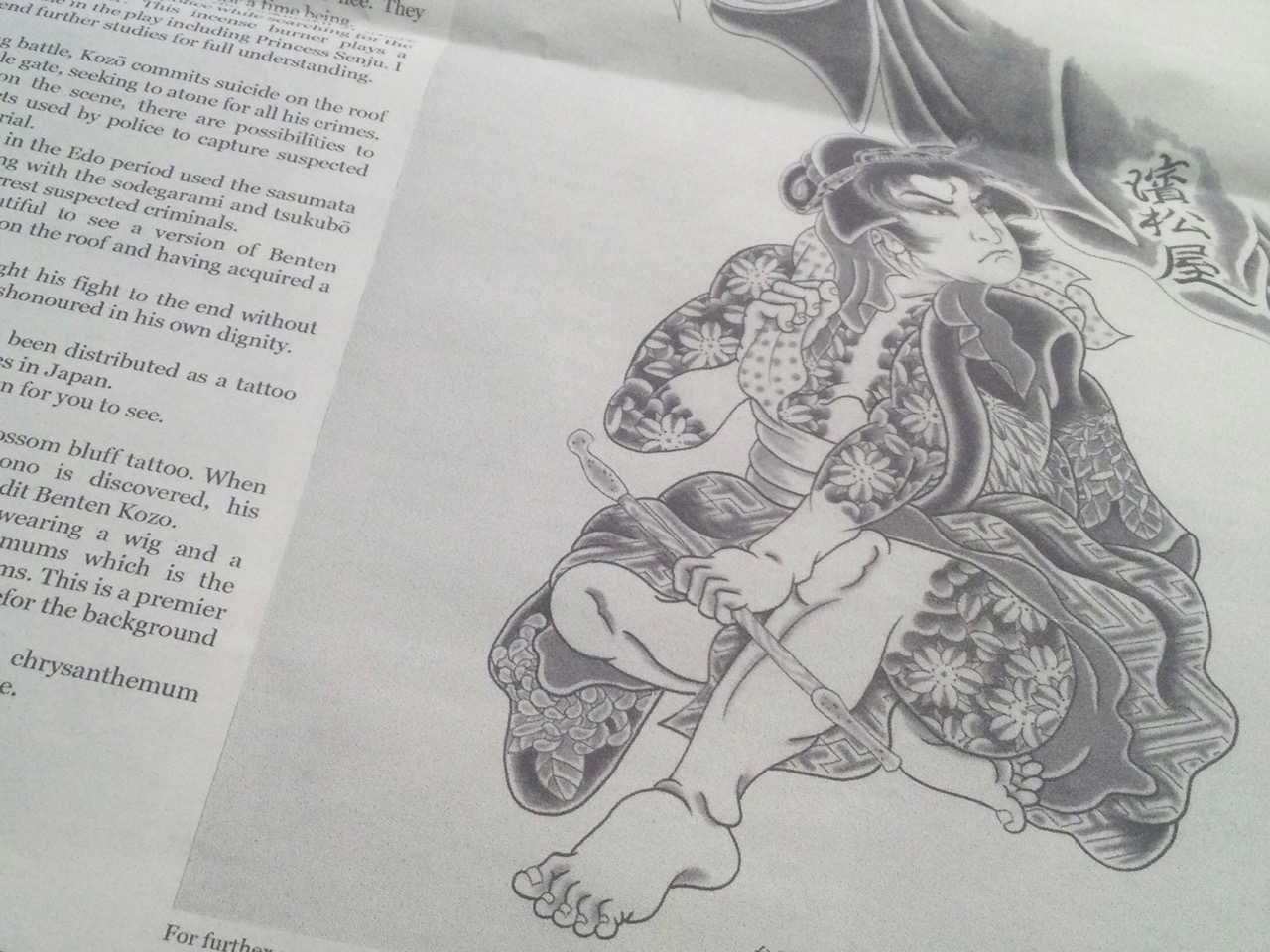Lets talk 40 years of Tebori…
Yet again publisher Patrick Kitzel from Syracuse features sensei horikoi from Toyohashi in the 2021 Summer/Fall issue of Tattoo Today Skin Deep Newspaper. It’s the first newspaper of this kind to come out internationally. Please note that it is not a magazine. The newspaper is always containing bits and bobs evolving around the current situation in the real tattoo scene.
People have a connection to each other and have a reason to be in it. Here we are not talking about perfect line work and the newest colour combination. We are not talking about a designer product that is made to model the like of the mainstream.
Featuring people who paved the way and really have something to say, we enjoy every paper.
Shodai Horikoi from Toyohashi, Japan, was a man who produced handcrafted tattoos (Jap. Tebori Method) for over 40 years.
Benten Kozō Kikunosuke
In this last article you can read about sensei’s thoughts about a better tattoo world and the story of bandit “Benten Kozō Kikunosuke”. There is a reason why he chose this hero. Can you dig it?
Sadly by the time you read this it’s highly probable that the issue is sold out.
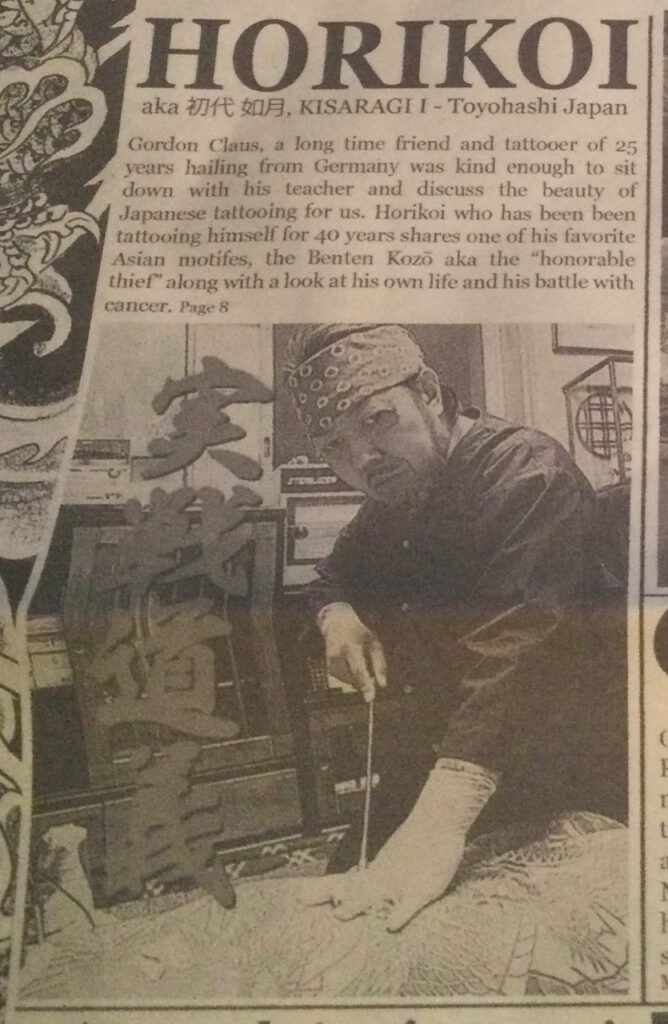
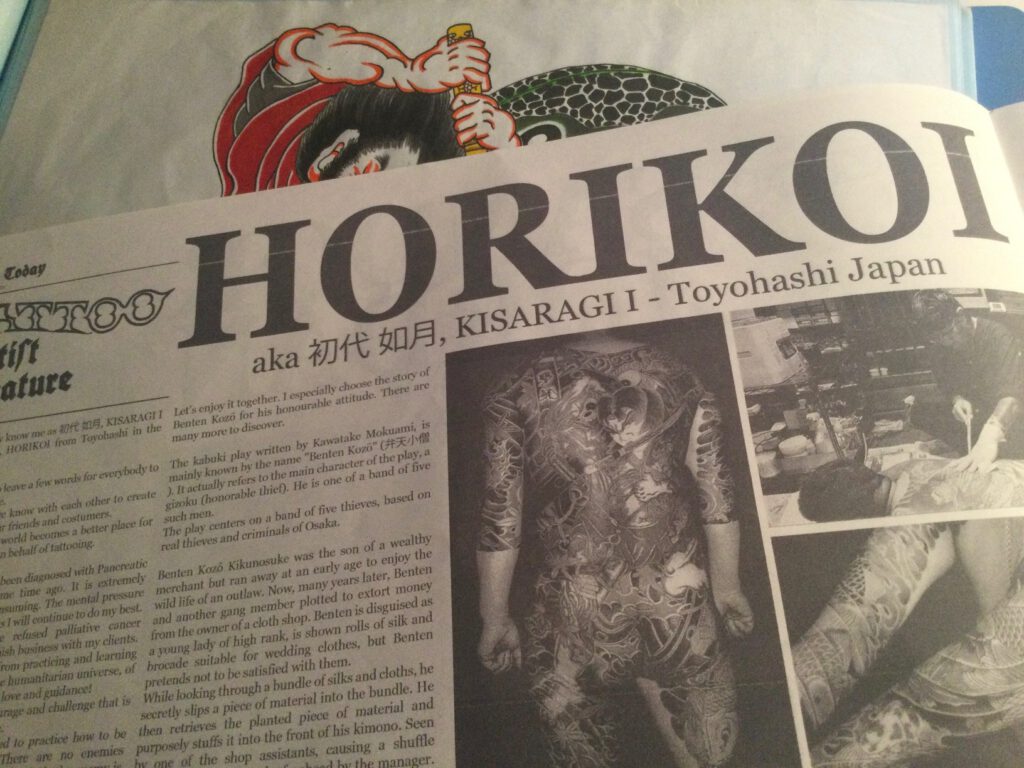
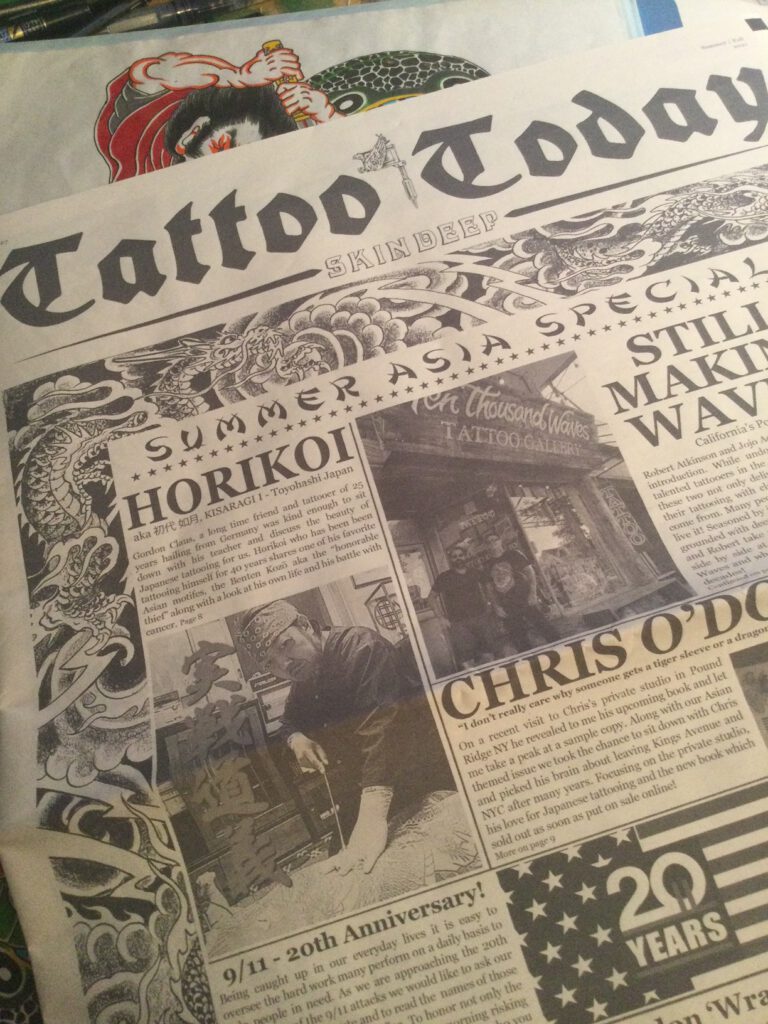
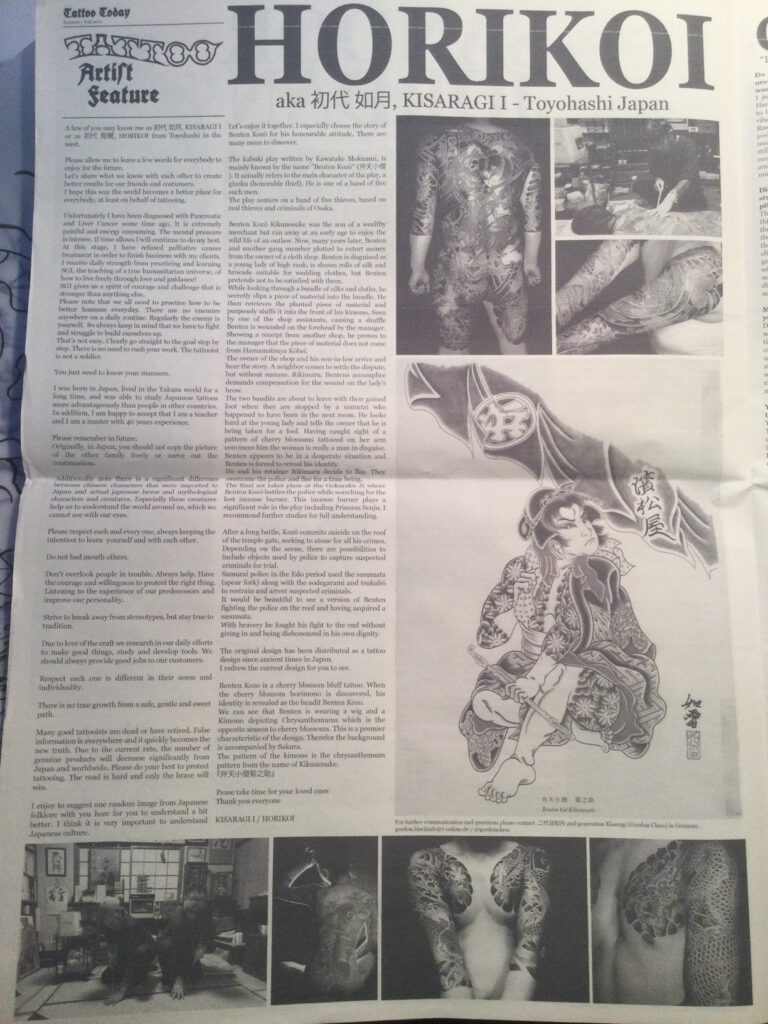
The interview for you to read:
The Interview courtesy of P.K and Sensei Horikoi.
Dear readers,
A few of you may know me as:
初代 如月, KISARAGI FIRST or as
初代 彫鯉, HORIKOI from Toyohashi in the west.
Please allow me to leave a few words for everybody to enjoy for the future.
Let’s share what we know with each other to create better results for our friends and costumers.
I hope this way the world becomes a better place for everybody, at least on behalf of tattooing.
Enjoying life as much as possible with cancer…
Unfortunately I have been diagnosed with Pancreatic and Liver Cancer some time ago. It is extremely painful and energy consuming. The mental pressure is intense. If time allows I will continue to do my best. At this stage, I have refused palliative cancer treatment in order to finish business with my clients.
I receive daily strength from practicing and learning SGI, the teaching of a true humanitarian universe, of how to live freely through love and guidance!
SGI gives us a spirit of courage and challenge that is stronger than anything else.
Please note that we all need to practice how to be better humans everyday. There are no enemies anywhere on a daily routine. Regularly the enemy is yourself. So always keep in mind that we have to fight and struggle to build ourselves up.
That’s not easy. Clearly go straight to the goal step by step. There is no need to rush your work. The tattooist is not a soldier.
The true steps of a honest man.
You just need to know your manners.
I was born in Japan, lived in the Yakuza world for a long time, and was able to study Japanese tattoos more advantageously than people in other countries. In addition, I am happy to accept that I am a teacher and I am a master with 40 years experience.
Please remember in future:
Originally, in Japan, you should not copy the picture of the other family freely or carve out the continuation.
Additionally note there is a significant difference between chinese characters that were imported to Japan and actual japanese heros and mythological characters and creatures. Especially these creatures help us to understand the world around us, which we cannot see with our eyes.
Please respect each and every one, always keeping the intention to learn yourself and with each other.
Do not bad mouth others.
Don’t overlook people in trouble. Always help. Have the courage and willingness to protect the right thing.
Listening to the experience of our predecessors and improve our personality.
Strive to break away from stereotypes, but stay true to tradition.
Due to love of the craft we research in our daily efforts to make good things, study and develop tools. We should always provide good jobs to our customers.
Respect each one is different in their sense and individuality.
There is no true growth from a safe, gentle and sweet path.
Protect Tattooing by all means.
Many good tattooists are dead or have retired. False information is everywhere and it quickly becomes the new truth. Due to the current rate, the number of genuine products will decrease significantly from Japan and worldwide. Please do your best to protect tattooing. The road is hard and only the brave will win.
I enjoy to suggest one random image from Japanese folklore with you here for you to understand a bit better. I think it is very important to understand japanese culture.
Let’s enjoy it together. I especially choose the story of Benten Kozō for his honourable attitude. There are many more to discover.
The kabuki play written by Kawatake Mokuami, is mainly known by the name “Benten Kozō” (弁天小僧). It actually refers to the main character of the play, a gizoku (honorable thief). He is one of a band of five such men.
The play centers on a band of five thieves, based on real thieves and criminals of Osaka.
Benten Kozō Kikunosuke owns sophisticated strategy.
Benten Kozô Kikunosuke was the son of a wealthy merchant but ran away at an early age to enjoy the wild life of an outlaw. Now, many years later, Benten and another gang member plotted to extort money from the owner of a cloth shop. Benten is disguised as a young lady of high rank, is shown rolls of silk and brocade suitable for wedding clothes, but Benten pretends not to be satisfied with them.
While looking through a bundle of silks and cloths, he secretly slips a piece of material into the bundle. He then retrieves the planted piece of material and purposely stuffs it into the front of his kimono. Seen by one of the shop assistants, causing a shuffle Benten is wounded on the forehead by the manager. Showing a receipt from another shop, he proves to the manager that the piece of material does not come from Hamamatsuya Kōbei.
The owner of the shop and his son-in-law arrive and hear the story. A neighbor comes to settle the dispute, but without success. Rikimaru, Bentens accomplice demands compensation for the wound on the lady’s brow.
The two bandits are about to leave with their gained loot when they are stopped by a samurai who happened to have been in the next room. He looks hard at the young lady and tells the owner that he is being taken for a fool. Having caught sight of a pattern of cherry blossoms tattooed on her arm convinces him the woman is really a man in disguise. Benten appears to be in a desperate situation and Benten is forced to reveal his identity.
He and his retainer Rikimaru decide to flee. They overcome the police and flee for a time being.
The final act takes place at the Gokuraku Ji where Benten Kozō battles the police while searching for the lost incense burner. This incense burner plays a significant role in the play including Princess Senju. I recommend further studies for full understanding.
Benten Kozō Kikunosuke saves his dignity.
After a long battle, Kozō commits suicide on the roof of the temple gate, seeking to atone for all his crimes.
Depending on the scene, there are possibilities to include objects used by police to capture suspected criminals for trial.
Samurai police in the Edo period used the sasumata (spear fork) along with the sodegarami and tsukubō to restrain and arrest suspected criminals.
It would be beautiful to see a version of Benten fighting the police on the roof and having acquired a sasumata.
With bravery he fought his fight to the end without giving in and being dishonoured in his own dignity.
So in future, please admit to your sins and crimes.
The original design has been distributed as a tattoo design since ancient times in Japan.
I redrew the current design for you to see.
Benten Kozō Kikunosuke is a cherry blossum bluff.
Benten Kozo is a cherry blossom bluff tattoo. When the cherry blossom horimono is discovered, his identity is revealed as the bandit Benten Kozo.
We can see that Benten is wearing a wig and a Kimono depicting Chrysanthemums which is the opposite season to cherry blossoms. This is a premier characteristic of the design. Therefor the background is accompanied by Sakura.
The pattern of the kimono is the chrysanthemum pattern from the name of Kikunosuke.
『弁天小僧菊之助』
For further communication and questions please contact
二代目如月 second generation Kisaragi (Gordon Claus) in Germany.
Pease take time for your loved ones
Thank you everyone
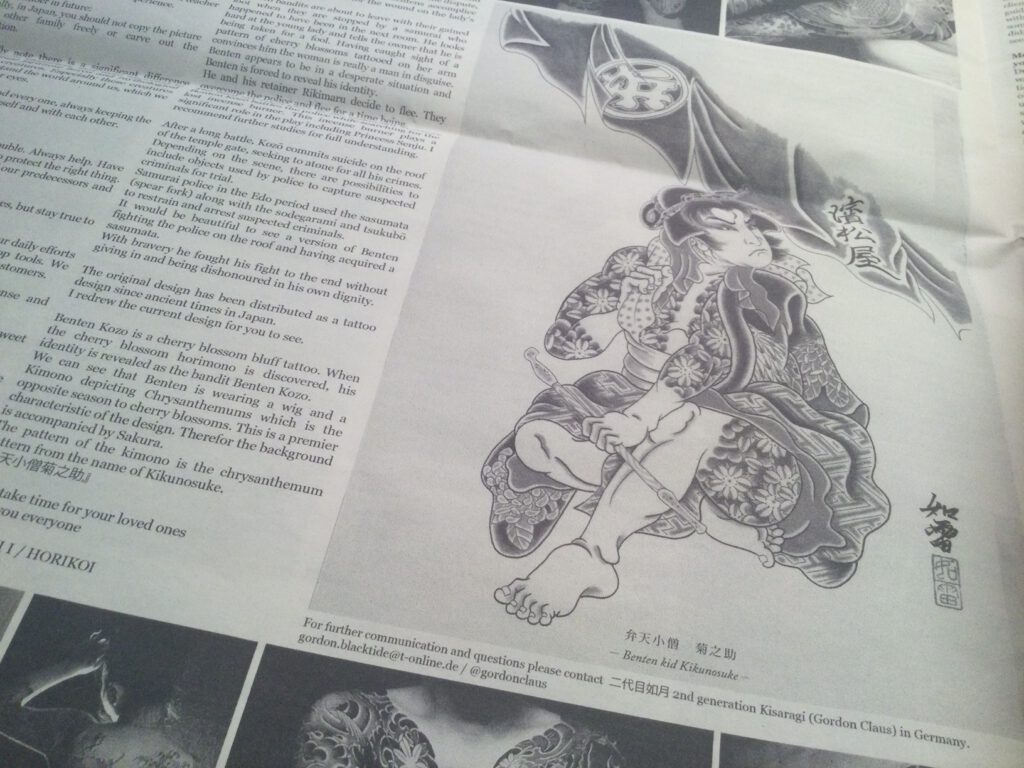
We hope you enjoyed this post as much as we did.
Blessings, Lars Walkling, Rick Wilson and Gordon Claus a.k.a. 2nd Generation Kisaragi

